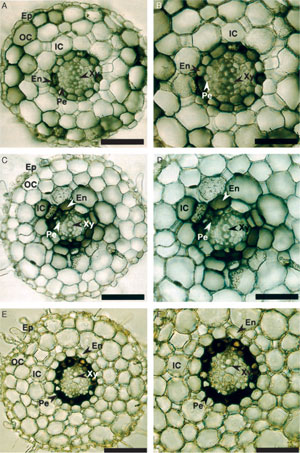Molecular Biology of Plant Pathways / Engineering Plant Alkaloid Biosynthetic Pathways
Cell-Specific Expression of Tropane Alkaloid Biosynthetic Genes
The main site of tropane alkaloid biosynthesis was demonstrated to be in the
roots by classical grafting experiments in which scions from tropane alkaloidproducing
species were grafted onto rootstock from nonproducing species. The
resultant plants did not accumulate alkaloids. The reciprocal graft experiments
yielded plants that accumulated alkaloids (cited in Hashimoto
et al., 1991). These
experimental results suggest that tropane alkaloids are synthesized in roots and
transported to aerial parts of the plant. With these early experiments in mind,
histochemical localization of
pmt,
tr-I,
tr-II, and
h6h has been carried out.
tr-I and
h6h, specific to scopolamine biosynthesis, and
tr-II, specific to
calistegin biosynthesis, have been localized to the
H. niger root (Hashimoto
et al., 1991; Nakajima and Hashimoto, 1999). Accumulation was highest in
 |
| FIGURE 10.12 Immunohistochemical localization
of tr-I, tr-II, and h6h in root cross-sections
of H. niger (Nakajima and Hashimoto, 1999).
Panels (A, B) tr-I; panels (C, D) tr-II; panels
(E, F) h6h.
Ep, epidermis; OC, outer cortex;
IC, inner cortex; En, endodermis; Pe, pericycle;
Xy, xylem. |
lateral roots.
tr-I and
tr-II accumulated with cell-specific patterns that differed from those of
h6h, implying a transport of an alkaloid biosynthetic intermediate that must
occur somewhere between tropine and hyoscyamine (Fig. 10.12). Using GUS
fusions,
A. belladonna pmt promoter activity has been histochemically localized to
root pericycle and
h6h promoter activity was found both in root pericycle and
tapetum and pollen grains (Suzuki
et al., 1999a,b) The cell-specific expression of
these promoters appears to be species specific (Kanegae
et al., 1994).
Once again, multiple cell types are involved in an alkaloid biosynthetic
pathway and transport of biosynthetic intermediates must be involved, thereby
introducing another possible level of regulation.





